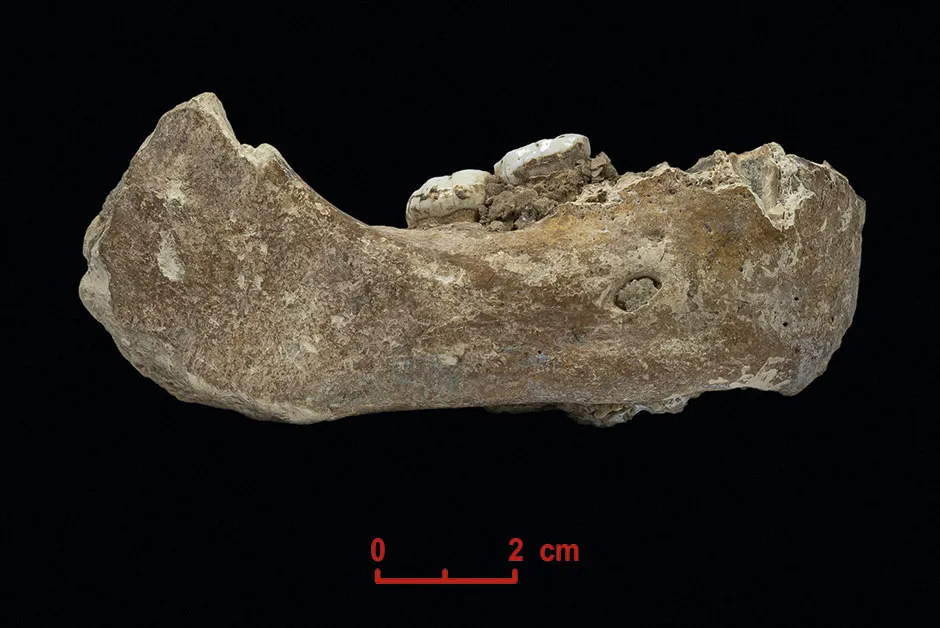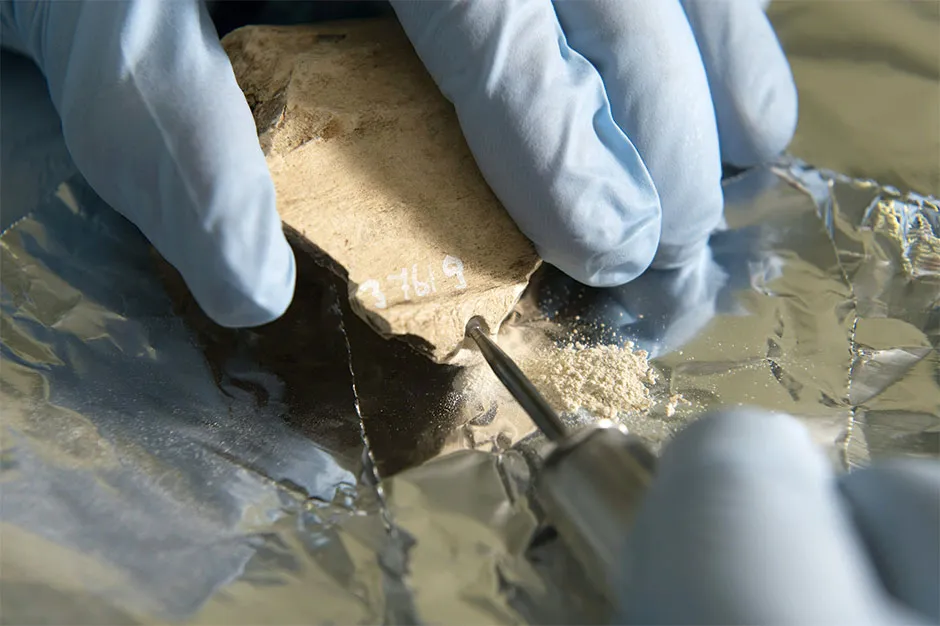Ancient DNA teased out from the fossilised bones and teeth of human species has transformed what we know about our ancestors. Over the past two decades, analysis of genetic material has not only revealed new human species, but it’s also allowed archaeologists to recreate what our ancestors looked like, thousands of years after they went extinct.
But it can’t give us the whole story because DNA is fragile – it breaks down over time to the point where its code becomes unintelligible. This has meant that many ancient bones can’t be analysed genetically, therefore much of the human family tree has remained hidden from view.
But over the past few years, new insights into our ancient ancestors have come from the proteins locked inside fossilised remains. Proteins can survive much longer than DNA, and advances in lab techniques, such as mass spectrometry, have increased researchers’ ability to detect and characterise tiny amounts of them.
Most promising of all is ‘shotgun proteomics’, a technique that creates a profile of all the proteins inside a fossilised bone or tooth. These ‘protein fingerprints’ have already proven their ability to identify which species of ancient human fossilised bones belonged to, even when DNA evidence has been lost.
It means we’re on the cusp of a ‘palaeoproteomics’ revolution that promises to provide an unprecedented view of who our ancient relatives were and how they lived.
Read more of the ideas you need to know in 2021:
- Phobias, paranoia and PTSD: Why virtual reality therapy is the frontier of mental health treatment
- The cracks in cosmology: Why our Universe doesn't add up
- Rewilding: Can it save our wildlife and temper climate change?
- How swarm spacecraft could help us understand Earth like never before
- Rise of the Clones: 7 ways cloning is already happening
Digging deeper into the Denisovans
Anthropologists are particularly keen to learn more about the Denisovans, a mysterious tribe of humans who lived at least 200,000 to 50,000 years ago. So far, their genetic material has only been recovered from one site: the Denisova Cave in the foothills of Siberia’s Altai Mountains.
But there’s evidence that they were much more widespread. People alive today in Asia, Australia and Papua New Guinea have Denisovan DNA in their genetic code.
“Almost every [question we have] about the Denisovans is unanswered,” says Dr Frido Welker at the University of Copenhagen in Denmark who’s a leader in the field of ancient proteins. “It’s not only that we need to know where they lived, we also don’t know what kinds of stone tools they made, we don’t know their hunting behaviour.”
The most complete remains of a Denisovan found so far is half a lower jawbone with two teeth attached that was discovered by a monk in Baishiya Karst Cave high on the Tibetan Plateau in China.

The DNA inside the jaw, thought to be at least 160,000 years old, was too degraded to analyse. But in 2019, a team that included Welker managed to analyse the collagen protein in the teeth and it was a match for the Denisovans found at Denisova Cave. It was the first time an ancient human had been identified only from its proteins.
Protein analysis is now being used to comb through thousands of bone fragments dug up from archaeological sites across Europe and Asia to identify which belonged to ancient humans, and which belonged to animals such as hyenas and mammoths.
By doing this, the FINDER research project at the Max Planck Institute for the Science of Human History in Jena, Germany, is increasing the number of bone samples known to be from ancient humans. This will provide a much larger range of ancient human bones for analysis.

Understanding ancient diets
As well as using DNA, archaeologists have studied the shapes and dimensions of bones to identify species and consider where they might fit into our evolutionary past.
But much of what they find is just small shards that can’t be identified. “Back in the 1950s, or even earlier, [archaeologists] would chuck these bone fragments away because they’d be of no value to them,” says Dr Katerina Douka, who is leading FINDER.
Douka is using a technique called Zooarchaeology by Mass Spectrometry (ZooMS) to identify the bone shards. In ZooMS, collagen protein is extracted from the bones and broken down with trypsin, an enzyme that helps to digest protein in our stomachs.
Trypsin chops the collagen into peptides (chains of amino acids), which are then placed in a mass spectrometer so their masses can be measured. The peptides are present in different ratios in human remains compared to those of animals, allowing human bones to be identified.

So far 11,000 bone fragments from the Denisova Cave have been analysed using ZooMS, and 10 human bones identified. Some of them are almost 250,000 years old, so likely beyond genetic analysis. After all, DNA has only been sequenced from three hominin groups; Neanderthals, Denisovans and Homo sapiens – and mostly from the past 100,000 years.
DNA’s tendency to break down over time is a problem Welker is familiar with from his days as an undergraduate. He was trying to sequence genetic material trapped within the fossilised dung of an extinct mountain goat (Myotragus balearicus) to find out what it ate by identifying the genes of any plants it had digested.
“It didn’t work because [the DNA] was absolutely knackered in terms of preservation,” he says. “The next best thing seemed to be proteins.”
Read more about human evolution:
- Are humans still evolving?
- Did Neanderthals have a society?
- Lucy and Ardi: The two fossils that changed human history
In December 2020, Welker started work on a major new research project sequencing the proteins in hominin fossils from the past million years, that had been collected across Africa, Europe and Asia.
He has received €1.5m (£1.35m approx) from the European Research Council to analyse bone and teeth samples from museums and universities. “Between 700,000 and 200,000 years ago is an exciting period for understanding where we, as a species, originate and what the hominin species at the time were doing, behaviourally speaking,” says Welker.
It’s the period when Homo heidelbergensis, the species that we, Homo sapiens, are thought to have descended from, first came about, having evolved from Homo erectus.
“There are several species designations out there, like Homo heidelbergensis where either people disagree on how it should be placed in relation to us, or whether it exists or not,” says Welker. “The good thing is that, for that time period and Homo heidelbergensis specifically, proteins can be very informative in the coming years to resolve some of those questions.”

The shotgun proteomics technique Welker will be using starts by drilling into bone or tooth to create a breadcrumb-sized amount of powder. Typically, the powder is placed in hydrochloric acid to release the proteins, which are then sliced into peptides using trypsin.
Just as in ZooMS, the peptides’ masses are measured in a mass spectrometer. But shotgun proteomics differs from ZooMS in that the data from the mass spectrometer also allows researchers to determine the sequence of amino acids within the peptides – and it does this for all the proteins in the sample, rather than just one.
So while ZooMS can tell whether a bone came from an ancient human or something else, a protein sequence from shotgun proteomics can be compared with those already known to occur in hominin species to identify the specific species.
Furthermore, as the amino acid sequence of a protein is determined by the genome, variation in the sequence that might exist between species tells researchers something about the evolutionary relationship between the fossil being studied and other hominin species.
The future of proteomics
Over the next few years, it’s expected that shotgun proteomics will allow researchers to identify the species present at more archaeological sites, providing a clearer picture of where the likes of the Denisovans lived.
Also, by identifying the species present at a location, archaeologists can use the artefacts there to piece together more information about them, such as the prey they hunted and whether or not they used fire.
But it won’t be easy. Many of the shards of bone that researchers work with only have a limited number of proteins in them – they are, after all, a tiny fragment from one part of the skeleton. So they contain much less information than an entire genetic code.
Proteins are also ‘evolutionarily conserved’, meaning they often don’t change a great deal between species because they’re doing the same job. This limits the extent to which they can be used to link a bone sample to a specific species.
But proteins have already shown themselves to be much more resilient than DNA, allowing us to peer further back in time than ever before. Right now, we just don’t know how far back proteomics will allow us to see.
“It’s exciting to have been part of what has happened in the field in the past couple of years,” says Welker. “Even now, I still don’t know what its limits are. That’s only a good thing, because it means we still have lots of things to explore.”
- This article first appeared inissue 358ofBBC Science Focus Magazine–find out how to subscribe here
